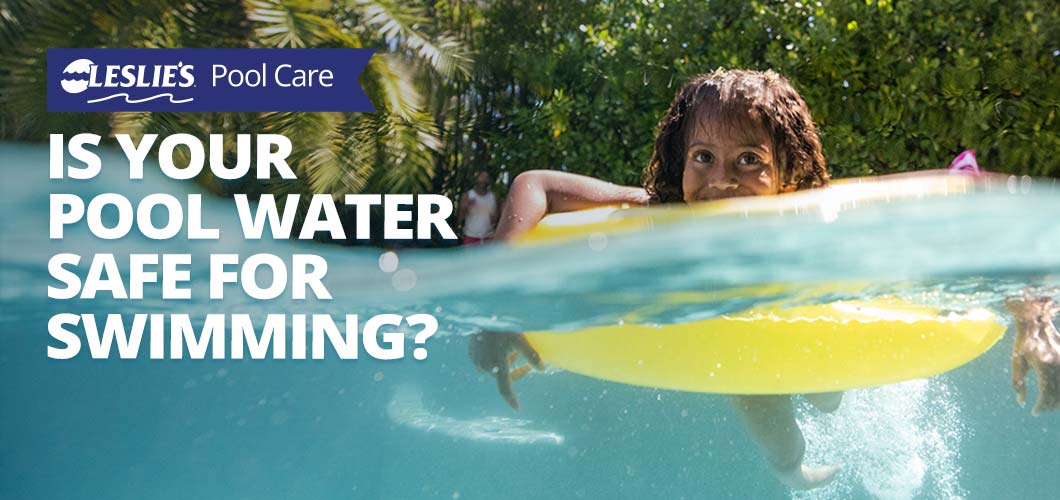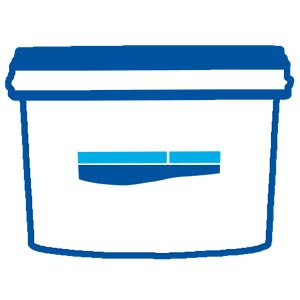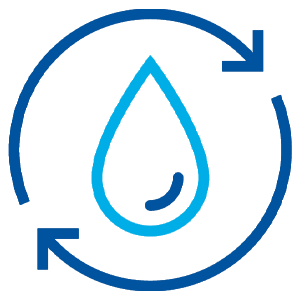
Is Your Pool Water Safe for Swimming?
Your pool may be free of debris, and the water may look crystal clear, but it could be hiding some unpleasant secrets just below the surface. No matter how clean it might appear, pool water that’s not properly balanced and sanitized isn’t actually clean at all. Do you have safe water in your pool? Keep reading to find out if your water is actually swim-ready, or if you’ve got some work to do.
Pool Water Safety Myths
Let’s start by busting a few common pool care myths relating to swimming pool water quality standards.
Myth #1: The smell of chlorine near my pool is strong. That means the water is sanitized.
FALSE. Contrary to popular belief, the scent of chlorine doesn't always mean the pool is sanitized. When you smell a strong odor of chorine, it usually means there's not enough Free Available Chlorine in the pool. That harsh scent comes from inactive chlorine, which has bonded to ammonia molecules — a combination known as Combined Available Chlorine or chloramine. If you start smelling strong odors of chlorine near the pool, it's time to check your chlorine levels.
Myth #2: My pool looks clean, and the water’s clear. That means my pool water is safe for swimming.
FALSE. Without looking at the water chemistry to know if there’s adequate chlorine levels in the pool, you have no idea if your water is actually sanitized. Unsanitized pools are a breeding ground for disease-causing microorganisms, and they love to hide in plain sight.
Myth #3: I clean my pool often and run the filtration system 12+ hours per day. Surely it’s safe to swim in.
FALSE. It doesn't matter how much time and effort you put into skimming, brushing, vacuuming, circulating, and filtering your pool. If there’s not enough chlorine in the water, your pool’s not actually clean, and the water's not safe.
Myth #4: The water’s only a little cloudy/green. Otherwise, it looks pretty clean. It’s probably OK for swimming, right?
FALSE. Under no circumstances is it ever safe to swim in cloudy or green pool water. For starters, if your pool is green and growing algae, it's a pretty good indicator that your water isn't adequately sanitized. And aside from the general safety hazards of limited visibility, cloudy water is often a symptom of poor water balance and — you guessed it — low sanitizer levels.
Now that that’s out of the way, let’s look at some ways to keep your water clean, beautiful, and most importantly, SAFE.
SAFETY TIP: Unsanitary or contaminated water can spread swimming-related illnesses, including skin rashes, ear pain, respiratory infections, and diarrhea. According to the CDC, 1 in 10 routine public pool inspections during 2008 identified low disinfectant levels, and 1 in 8 pools had poor water chemistry, both of which contribute to unsanitary water conditions. To avoid these scenarios in your home pool, maintain a Free Available Chlorine level of 2.0–4.0 ppm, maintain proper water balance, and stay out of the water if you're not feeling well. For more water sanitation, health, and safety tips, check out our blog post.
How to Maintain Safe and Healthy Pool Water
So what is safe water? What does it take to maintain a healthy pool? When is a pool unsafe to swim in? If you want a pool that's ready for swimming anytime, keep reading to learn about a few key water care tips, including:

Make sure there's plenty of chlorine in the pool water to keep it safe.

Routinely test and balance your pool water to keep it healthy.

Run the pump to circulate the water and filter out debris, keeping your pool water clear.

Skim, brush, and vacuum each week to keep your pool clean and beautiful.
Maintain Adequate Sanitizer Levels
Keeping the proper level of Free Available Chlorine is one of the most important keys to a healthy swimming pool. Without sanitizer, your pool can’t fight off organic contaminants like algae or disease-causing microorganisms, including . And if it can’t fight off those contaminants, they quickly take over the pool — especially in warmer temperatures. This makes for unsanitary pool conditions, and the water is unsafe to swim in or enjoy.
Routinely check your water to ensure your Free Available Chlorine (FAC) level stays between 2.0–4.0 ppm (parts per million). This is the ideal chlorine level in a pool. Also keep track of your Total Available Chlorine (TAC) reading. If your TAC level is 0.3 ppm higher than the FAC reading or less than 2.0 ppm, it’s time to shock the pool.
If using stabilized trichlor tablets, such as Leslie's 3" Jumbo Tabs, keep your automatic chlorinator or floating chlorine feeder full. Ensure the proper setting to provide a consistent chlorine supply throughout the week. If your levels are chronically low, your chlorinator isn’t dispensing enough chlorine.
In addition to using chlorine tablets or another primary sanitizer, you’ll also want to shock the pool at least once a week to keep the water safe. This will oxidize the water to break down organics, free up available chlorine, and destroy chloramines. "What are chloramines," you may ask? They're combined inactive chlorine molecules that can irritate your skin, eyes, and even your nose with their strong odor. Use a non-chlorine pool shock (Leslie’s Fresh ‘N Clear) if FAC levels are higher than 2.0 ppm. If the FAC level is lower than 2.0 ppm, use chlorine pool shock (Leslie’s Power Powder Plus 73, Leslie’s Chlor Brite, or liquid chlorine) to bring the level up.
Test and Balance Your Water
There are so many reasons why it’s important to test and balance your water. First and foremost, water balance plays a key role in sanitization and a safe and healthy pool environment. If the water’s not balanced, your chlorine can’t work efficiently. Or, in some cases, your chlorine may not be able to work at all. Imbalances in water chemistry can also lead to an array of other problems in your pool. These include scale buildup, pool stains, corrosion of pool surfaces and equipment, cloudy water, excess chemical usage, and an uncomfortable swimming experience. Keep an at-home test kit or test strips and essential water balancing chemicals on hand in case you need them.
To get the most accurate assessment of what’s going on with your pool water, just bring a sample to your local Leslie’s for a free water test. Our industry-leading AccuBlue® technology provides an in-depth and precise 10-point water chemistry analysis in as little as 60 seconds. Once you have your results, you’ll also get a detailed step-by-step treatment plan to help you keep your pool clean, beautiful, and most importantly, safe.
EXPERT TIP: What is water balance? Why is it important? We dive into the 10 different aspects of water chemistry in our handy guide, Pool Chemistry 101. Learn what ideal water balance means, why it matters, and how to fix imbalances in your pool water.
Run the Pool Pump and Filtration System
To balance the water and distribute chlorine throughout the pool, your pump and filter should be in good working order. Regularly clean out the pump and skimmer baskets to ensure good water flow, and clean the filter as needed to keep it running efficiently. To help fight off algae during warm weather, your pump should run long enough each day to turn over the water at least one time. For particularly toasty temperatures, longer run times may be necessary. If you’re not sure how long to run your pump, check out our blog post for more helpful tips!
Clean the Pool
Thoroughly skim, brush, and vacuum your pool weekly to keep debris to a minimum. If you have an automatic pool cleaner, this part will be easy. But even with a cleaner running on a routine schedule, and even if it brushes the walls and floor for you, it’s still important to manually brush all pool surfaces regularly to keep your water safe. Pay particular attention to the corners of your pool, which often don't get much circulation, or may get missed by your cleaner. This will help keep your pool water pristine, and will help keep algae from adhering to the walls and crevices in your pool. Releasing contaminants from pool surfaces allows them to be neutralized by chlorine or removed by the filter.
Bonus Tip: Use Perfect Weekly
In addition to balancing, sanitizing, circulating, filtering, and cleaning your pool, it’s essential to keep the right pool chemicals in your cabinet. If you’re looking to get the most out of your pool maintenance budget this year, consider using Leslie’s Perfect Weekly. Perfect Weekly is a three-in-one maintenance chemical that contains enzymes, a phosphate remover, and a liquid solar cover to save you time and money on pool care.
Enzymes help optimize chlorine efficiency by breaking down organic contaminants, freeing up your chlorine to fight off germs and algae more effectively. This also helps extend chlorine's lifespan in the water.
Phosphates are essentially food for algae, so removing phosphates is an important part of maintaining a clean, safe, beautiful pool. Algae blooms can be costly and time-consuming to correct, so prevention is always best in this scenario.
Last, but not least, the liquid solar cover included with Perfect Weekly helps reduce evaporation, saving money on your monthly water bill.
Leslie’s Can Help Keep Your Pool Water Safe
To keep your pool water pristine, you can rely on the experts at Leslie’s to help. Bring a pool water sample to your local Leslie’s for a free in-store AccuBlue analysis and customized water treatment plan. We take the guesswork out of pool care, so you can spend less time maintaining it and more time enjoying it.